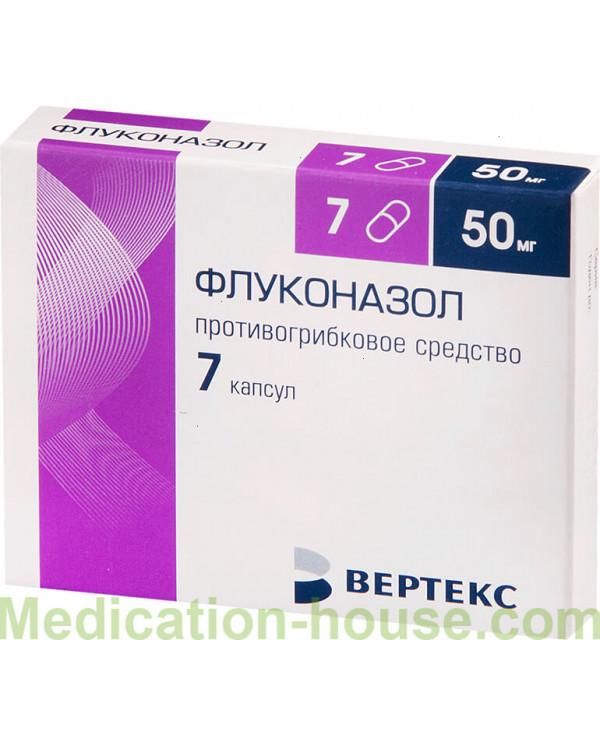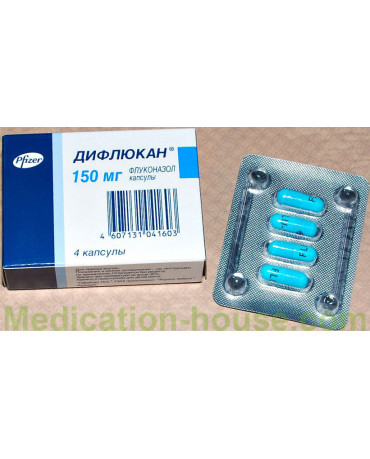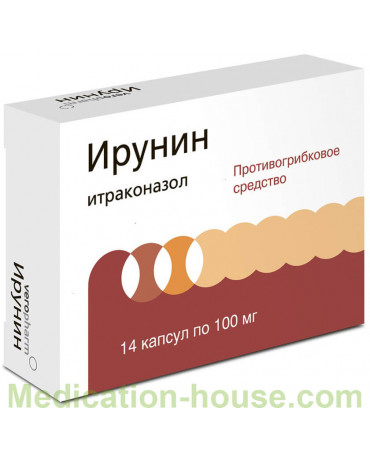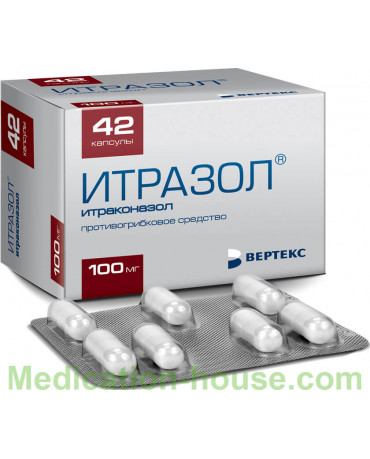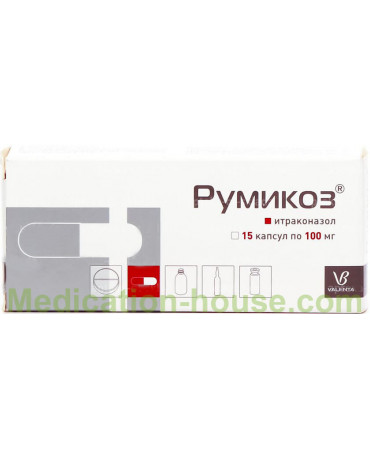Instruction for Fluconazole
You can buy Fluconazole here
It helps with candidal infections after bone marrow transplantation. It can be used both intravenously and inside in the form of capsules.
Fluconazole is active in opportunistic mycoses, incl. caused by candida spp. (including generalized forms of candidiasis in the presence of immunosuppression), Cryptococcus neoformans and Coccidioides immitis (including meningitis and encephalitis), Microsporum spp. and Trichophyton spp; with endemic mycoses caused by Blastomyces dermatidis, Histoplasma capsulatum (including immunosuppression).
After taking the medicine inside the highest concentration in the blood takes place after 0.5-1.5 hours. The half-life of blood is 30 hours. That is, you can take the drug once a day.
Composition and release form
This medicine is available in capsules 150 mg, 50 mg, 100 mg. These are capsules of blue color, the white or yellowish granulated powder inside contains. Contained in blisters, which are put in cardboard boxes.
The composition of the drug in the form of capsules includes the active ingredient fluconazole. Capsules also contain additional components: potato starch, low molecular weight polyvinylpyrrolidone, calcium stearate or magnesium stearate.
Fluconazole tablets, syrup, gel, suppositories and IV solution are also produced. introduction.
Pharmacological effect
The abstract contains information that the drug acts as an antifungal agent, inhibiting specifically the synthesis of fungal sterols. It belongs to the class of triazole compounds.
There is a specific effect on the enzymes of fungi, which depend on cytochrome P450. The active substance shows activity against various strains of Candida spp. (including effective for visceral candidiasis), Cryptococcus neoformans (including effective for intracranial infections), Trichophytum spp, Microsporum spp. Also, the drug is active against microorganisms that are causative agents of endemic mycoses: Coccidioides immitis, Hystoplasma capsulatum, Blastomyces dermatitidis.
The tool suspends the transformation of fungal cells into ergosterol lanosterol. Under its influence the permeability of the cell membrane increases, the process of its growth and replication is inhibited. It is highly selective for cytochrome P450 fungi, but in the human body it almost does not inhibit these enzymes. Antiandrogenna activity does not show.
Pharmacokinetics
After oral administration, fluconazole is well absorbed, food intake does not affect the rate of absorption of fluconazole, its bioavailability is 90%. Fluconazole penetrates well into all body fluids. The concentration of the active substance in breast milk, joint fluid, saliva, sputum, and peritoneal fluid is similar to that in blood plasma.
Constant values in vaginal secretion are reached 8 hours after ingestion and are held at this level for at least 24 hours. Fluconazole penetrates well into the cerebrospinal fluid (CSF), with fungal meningitis, the concentration in CSF is about 85% of its plasma level. In the sweat fluid, epidermis and the stratum corneum (selective accumulation) concentrations exceeding serum levels are achieved.
Excreted mainly by the kidneys (80% - unchanged, 11% - as metabolites).
Indications for use
What helps? Fluconazole has an active action against fungal pathogens of various diseases. The drug is prescribed in such cases as:
Onychomycosis.
Balanitis candida nature.
Mycoses of the feet, body, skin of the groin area.
Pityriasis and color versicolor.
Deep epidermal mycosis.
Cryptococcosis. Any localization of the lesion, including the brain, lungs and skin. The drug is suitable for patients with a normal immune response, as well as effective for the treatment of patients with reduced immunity, after transplantation or with immunodeficiency syndrome.
Candidiasis of the generalized form, candidosis, disseminated candidiasis and other types of invasive infections affecting the peritoneum, endocardium, eye tissue, respiratory and urinary systems. The positive quality of the drug is that treatment can be carried out in patients with cancer, being in reanimation, receiving a course of immunosuppressive or cytostatic therapy.
Candidiasis of mucous membranes of various localization. Damage to the mouth and nasopharynx, esophagus, skin, lungs and bronchi, on the mucous membrane of the eyes.
Vaginal candidiasis in all forms of the disease, including acute, chronic and recurrent stages.
The pharmacological form, dosage and duration of the course are selected only by a doctor. In some cases, only local exposure is sufficient. For example, for oral thrush in children, only suspension is prescribed, and for genital recurrent candidiasis, in addition to Fluconazole vaginal suppositories, forms of systemic action, tablets or injections are required.
Contraindications
There are such contraindications for the use of this medication:
Age up to 4 years (for capsules);
Lactation period (for solution for infusion);
Simultaneous use with astemizole or terfenadine (against the background of continuous therapy with fluconazole at a dose of 400 mg per day), as well as other drugs that extend the QT interval;
Lactose intolerance, lactase deficiency, glucose-galactose malabsorption (for tablets and capsules, in which milk sugar is present as one of the auxiliary components);
Hypersensitivity to the components of the drug, as well as to other azole antifungal drugs in history.
Fluconazole is prescribed with caution in the following conditions / diseases:
Liver failure;
Renal failure (for solution for infusion);
Appearance of rash in patients with superficial fungal infection and systemic / invasive fungal infections during treatment;
Simultaneous use with potentially hepatotoxic drugs (for capsules);
The simultaneous use of fluconazole in a daily dose of up to 400 mg with terfenadine (for solution for infusion);
Potentially proarrhythmic states in patients with multiple risk factors (electrolyte imbalance, organic heart disease, simultaneous use with drugs causing arrhythmias, simultaneous use with acetylsalicylic acid, rifabutin and other cytochrome P450 inducers);
Pregnancy.
Appointment during pregnancy and lactation
Fluconazole use during pregnancy is possible only when the potential benefit to the mother outweighs the risk to the fetus.
Category of action on the fetus by the FDA - C (adequate studies in pregnant women have not been conducted).
Fluconazole penetrates well into breast milk, so its use in women during lactation is not recommended.
Dosage and method of use
As indicated in the instructions for use, the choice of the dosage form of the drug, the optimal dose and duration of the course of therapy is individual and depends on the indications, the patient's condition, the clinical and mycological responses to the antifungal agent.
The daily dose is determined depending on the nature of the infection and the severity of the disease.
In the case of switching from intravenous injection (infusion solution) to oral administration of the drug (capsules, tablets), it is not necessary to change the daily dose of fluconazole.
Capsules and tablets are taken orally, regardless of the meal, swallowing whole and squeezed glass of water.
The solution for infusion is administered intravenously (IV) drip, at a rate of not more than 200 mg / hour. Infusions are recommended using conventional transfusion kits using any of the following solvents: 20% dextrose solution, Ringer's solution, Hartman solution, 5% dextrose solution and 0.9% potassium chloride solution, 4.2% sodium bicarbonate solution, 0.9 % solution of sodium chloride.
Recommended dosing regimen for adult patients:
Candida Balanitis: once 150 mg;
Vaginal candidiasis (thrush): once 150 mg; in order to reduce the frequency of relapses, for prophylaxis, for 4–12 months, 150 mg once a month, sometimes more frequent use may be necessary;
Candidiasis (for prophylaxis): depending on the degree of probability of the development of a fungal infection - from 50 to 400 mg per day; high risk of generalized infection (for example, in patients with long-lasting or severe neutropenia after irradiation or chemotherapy with cytostatics), the recommended dose is 400 mg / day; Fluconazole is started to be applied several days before the predicted occurrence of neutropenia, with an increase in the number of neutrophils ≥ 1 thousand / μl therapy continues for another 7 days;
Skin lesions, including mycosis of the groin area and feet, candidiasis: for 14–28 days, 150 mg 1 time per week or 50 mg 1 time per day; treatment of foot mycoses may require a longer period, up to 6 weeks;
Cryptococcal infections, disseminated candidiasis, candidemia, other invasive candidal infections: 400 mg on the first day, then 200-400 mg once a day; the duration of the course depends on the clinical and mycological response (for example, cryptococcal meningitis - at least 6–8 weeks);
Cryptococcal meningitis in AIDS patients (for prophylaxis): after completing the full course of primary therapy with Fluconazole at a dose of 200 mg per day, treatment is allowed for a long time;
Oropharyngeal candidiasis: for 7–10 days, 50–100 mg once a day, course duration for immunosuppression is 14 days or more; in order to prevent recurrence in AIDS patients after the completion of the full course of primary therapy, a maintenance dose of 150 mg weekly is recommended;
Atrophic oral candidiasis associated with the wearing of dentures: for 14 days, 50 mg 1 time per day in the complex treatment with local antiseptics for the treatment of the prosthesis;
Candidiasis of the mucous membranes (with the exception of genital membranes): for 14–30 days, 50–100 mg 1 time per day;
Pityriasis versicolor: for 14 days, 300 mg 1 time per week (depending on the patient's response to fluconazole, a third dose may be required - 300 mg 1 time per week, and a single dose of 300-400 mg may suffice); alternative regimen: for 2-4 weeks, 50 mg 1 time per day;
Onychomycosis: 1 time per week, 150 mg to replace the infected nail; normally, it takes 3–6 months for fingers, 6–12 months - for toes; growth rate may depend on age and vary among different people over a wide range; after successful treatment of long-standing chronic infections, it is possible to change the shape of the nails;
Deep endemic mycoses: with therapy lasting up to 2 years, 200–400 mg per day (coccidioidomycosis — 11–24 months, paracoccidioidomycosis — 2–17 months, sporotrichosis — 1–16 months, histoplasmosis - 3-17 months).
The duration of therapy in children, as with similar infections in adults, depends on the clinical and mycological responses. Children's daily dose should not exceed that in adults (for similar reasons). Fluconazole is used once a day, daily, using a suitable dosage form. The maximum children's daily dose is 400 mg.
The recommended dosing regimen for children over 3 years old:
mucosal candidiasis: 3 mg / kg / day for at least 21 days;
esophageal candidiasis: 3 mg / kg / day for at least 21 days and another 14 days after symptom regression;
generalized candidiasis and cryptococcal infection (including meningitis): 6–12 mg / kg / day for 70–84 days, until the laboratory confirmed absence of pathogens in the liquor;
fungal infections in children with reduced immunity, in whom the risk of developing an infection is associated with neutropenia, developing as a result of irradiation or chemotherapy with cytostatics (for prophylaxis): 3–12 mg / kg / day depending on the duration of preservation and severity of induced neutropenia.
In children with impaired renal function, the daily dose of the drug is reduced in severity of renal failure in the same proportion as in adults.
Using the drug in the form of a solution in newborns (up to 4 weeks) is required to take into account that the excretion of fluconazole is slow. In children of the first 2 weeks of life, the drug is used in the same dose (mg / kg) as at an older age, but with an interval of 72 hours; at the age of 3-4 weeks, the same dose is administered at intervals of 48 hours.
Elderly patients in the absence of signs of renal failure dose adjustment is not required.
In case of impaired renal function, a loading dose of 50 to 400 mg is initially administered to adult patients, the subsequent daily doses are determined depending on QC (creatinine clearance) according to the following scheme:
CC> 50 ml / min - 100% of the recommended dose.
CC 11–50 ml / min (without dialysis) - 50% every 24 hours or 100% every 48 hours.
Dialysis patients - 100% after each dialysis session.
Adverse reactions
On the background of taking capsules Fluconazole may develop negative side effects from various organs and systems:
Cardiovascular system - an increase in the duration of the QT interval, arrhythmia rhythm reduction of the heart in the form of fluttering or blinking.
Nervous system - headache, dizziness, fatigue, less likely to develop seizures.
Blood and red bone marrow - a decrease in the number of platelets (thrombocytopenia), leukocytes (leukopenia), granulocytes (agranulocytosis), neutrophils (neutropenia) in the blood.
Allergic reactions - skin rash, toxic epidermal necrolysis, erythema multiforme exudative, anaphylactoid reactions (urticaria, angioedema, angioedema, anaphylactic shock).
The digestive system - reduced appetite, changes in taste, abdominal pain, nausea, accompanied by periodic vomiting, bloating (flatulence), impaired liver function with the development of jaundice, increased activity of the enzymes ALT, AST, alkaline phosphatase (indicators of damage to hepatocytes, as well as violations of the outflow of bile).
Very rarely, after starting the drug, hair (alopecia) may fall out, cholesterol and triglyceride levels rise, the concentration of potassium ions in the blood decreases, and the functional activity of the kidneys is disturbed. The appearance of signs of the development of negative pathological reactions is the basis for the abolition of the drug.
Overdose
With an overdose, the patient may experience nausea, diarrhea, vomiting, and in severe overdose, seizures may occur. There is evidence of isolated manifestations of hallucinations. In case of overdose, forced diuresis is applied, gastric lavage and hemodialysis are performed. Symptomatic treatment is also used.
special instructions
Before you start using the drug, read the specific instructions:
Treatment should continue until clinical and hematologic remission. Premature discontinuation of treatment leads to relapse.
In rare cases, the use of fluconazole was accompanied by toxic changes in the liver, including fatal, mainly in patients with serious comorbidities. In the case of hepatotoxic effects, are associated with fluconazole, they are not marked by an obvious dependence on the total daily dose, duration of therapy, sex and age of the patient. The hepatotoxic effect of fluconazole has usually been reversible; his symptoms disappeared after cessation of therapy. If clinical signs of liver damage appear that may be associated with fluconazole, the drug should be withdrawn.
AIDS patients are more likely to develop severe skin reactions with the use of many drugs. In cases where a rash develops in patients with a surface fungal infection and is regarded as definitely associated with fluconazole, the drug should be discontinued. When a rash appears in patients with invasive systemic fungal infections, they should be carefully monitored and fluconazole should be canceled when a bullous change or erythema multiforme occurs.
Care must be taken when taking fluconazole with cisapride, rifabutin or other drugs metabolized by the cytochrome P450 system.
Compatibility with other drugs
When using the drug, you must consider the interaction with other drugs:
Patients who receive high doses of theophylline or who are likely to develop theophylline intoxication should be monitored to identify symptoms of an overdose of theophylline, because simultaneous reception of fluconazole leads to a decrease in theophylline clearance from blood plasma.
There are reports of the interaction of fluconazole and rifabutin, accompanied by an increase in the serum concentration of the latter. With the simultaneous use of fluconazole and rifabutin, cases of uveitis are described. It is necessary to carefully observe patients who simultaneously receive rifabutin and fluconazole.
When fluconazole is used with warfarin, the prothrombin time increases (by an average of 12%). Recommended to control prothrombin time when fluconazole is combined with coumarin anticoagulants.
Fluconazole increases T1 / 2 from the plasma of oral hypoglycemic agents - sulfonylurea derivatives (chlorpropamide, glibenclamide, glipizide, tolbutamide) in healthy people. The combined use of fluconazole and oral hypoglycemic agents in patients with diabetes mellitus is allowed, but the physician must keep in mind the possibility of the development of hypoglycemia.
With simultaneous use of fluconazole, terfenadine and cisapride, cases of unwanted heart reactions, including pirouette-type arrhythmia, are described.
The simultaneous use of fluconazole and hydrochlorothiazide can lead to an increase in the concentration of fluconazole by 40%.
Increases the concentration of midazolam, and therefore increases the risk of psychomotor effects (more pronounced with the use of fluconazole orally than intravenously).
The simultaneous use of fluconazole and phenytoin can lead to an increase in plasma phenytoin concentration to a clinically significant extent. Therefore, if necessary, the joint use of these drugs is necessary to monitor the concentration of phenytoin with the correction of its dose in order to maintain the concentration of the drug within the therapeutic interval.
The combination with rifampicin reduces AUC by 25% and shortens T1 / 2 of plasma fluconazole by 20%. Therefore, patients receiving rifampicin at the same time, it is advisable to increase the dose of fluconazole.
It is recommended to control the concentration of cyclosporine in the blood of patients receiving fluconazole, since with the use of fluconazole and cyclosporine in patients with a transplanted kidney, taking fluconazole at a dose of 200 mg / day leads to a slow increase in plasma cyclosporine concentration.
In patients receiving the combination of fluconazole and zidovudine, there is an increase in the concentration of zidovudine, which is caused by a decrease in the conversion of the latter into its main metabolite, therefore, an increase in the side effects of zidovudine should be expected.
Increases the concentration of tacrolimus, and therefore increases the risk of nephrotoxic action.
Reviews
We offer you to read the reviews of people who used Fluconazole:
Annie
A good, inexpensive alternative to many capsules from thrush. For a more lasting effect, try combining fluconazole intake with a candle - zalain. More than confident that you will not get rid of thrush for one month. Zalain, also does not need repeated use - it is just one candle. If you notice that the exacerbation of thrush is somehow related to your sexual partner, then he, too, should be treated, for this there is a cream of zalain.
Galina
A good drug, but often it is blamed for inefficiency, and the culprit, in my opinion, is advertising. Advertise that one capsule is enough to defeat thrush. But this is not always the case - in most cases it is necessary to take a course, and in addition to being treated simultaneously with topical pimafucine or metrogyl plus, if the inflammation is present, and even the intestines are restored. In general, an integrated approach is needed here. And many of my friends looking at ads, drink a capsule and wait for help. The symptoms diminish, and then again everything is new. money transfer is obtained.
Inna
My son was born weak, often sick for up to three years. Against the background of the medications taken, a fungus constantly appeared in the mouth. The pediatrician advised to follow in order not to miss the first stage, which is easier to cure, otherwise intestinal dysbiosis can occur later. The doctor wrote down the dosage according to strict instructions on how to drink Fluconazole at that age.
Terms of sell
You can buy Fluconazole without a prescription.

